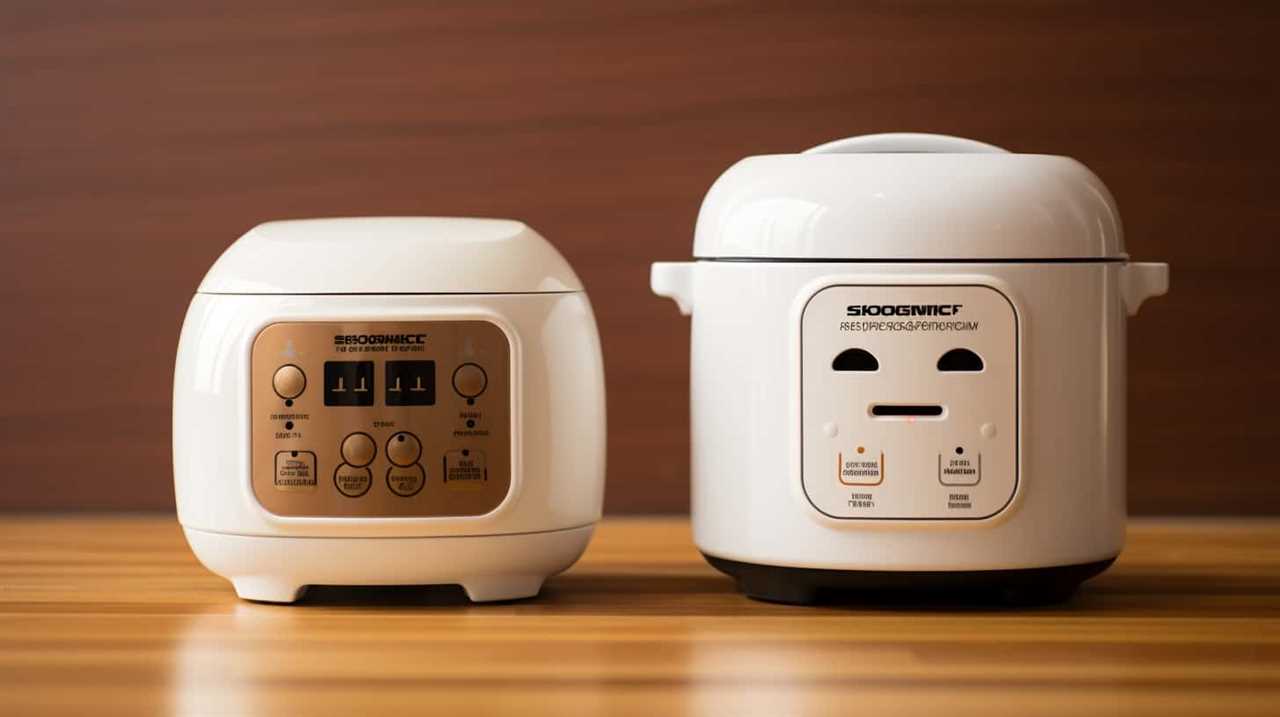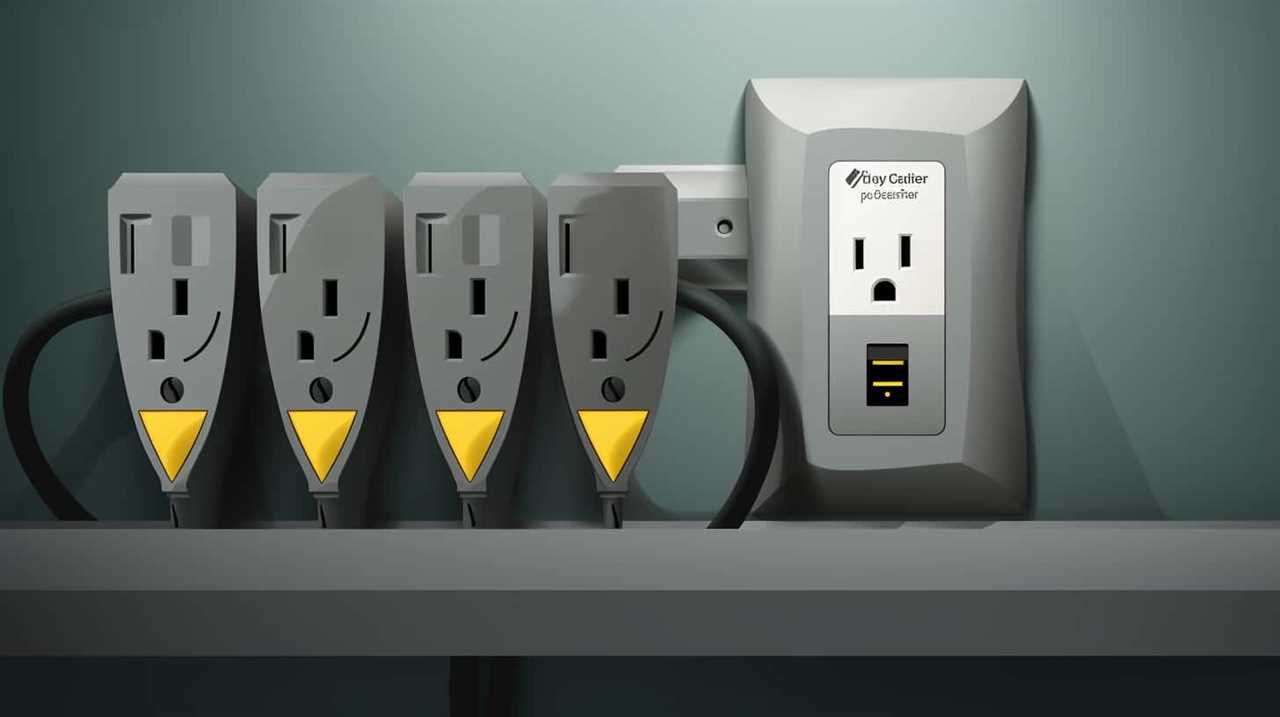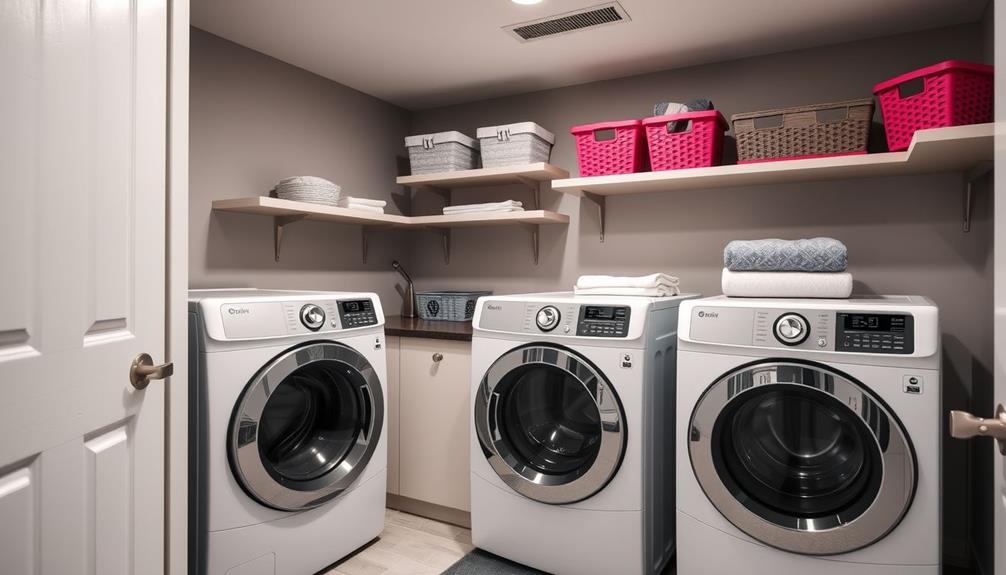When it comes to assessing the energy efficiency of an appliance, there are several key factors to consider. Energy Star Certification, the size and capacity of the appliance, its energy consumption and usage, efficiency ratings and labels, technological advancements, and energy-saving features all play a crucial role in determining its overall efficiency.
Additionally, proper maintenance and usage also contribute to the overall efficiency of an appliance. By understanding these factors, we can make informed decisions to ensure that our appliances are not only energy-efficient but also environmentally friendly.
In this article, we will delve into each of these factors, providing you with a comprehensive understanding of what determines an appliance’s energy efficiency. So, let’s explore the world of energy-efficient appliances together!
Key Takeaways
- Energy Star Certification is an important factor in determining an appliance’s energy efficiency, as it ensures that the appliance meets strict energy efficiency standards and offers benefits such as smart home integration.
- Appliance size and capacity play a significant role in energy efficiency, as smaller appliances require less energy and proper space utilization maximizes airflow and circulation.
- Energy consumption and usage patterns are crucial considerations for energy efficiency, as the amount of energy used by the appliance is influenced by its size and features. Energy-saving tips and proper usage can help reduce energy consumption.
- Efficiency ratings and labels provide valuable information for consumers to make informed decisions, as they indicate the appliance’s energy usage, compare different models, and higher ratings indicate higher energy efficiency.
Energy Star Certification
The Energy Star Certification is an official designation given to appliances that meet specific energy efficiency criteria. This certification is recognized worldwide and is backed by the U.S. Environmental Protection Agency (EPA) and the U.S. Department of Energy (DOE).

Appliances with the Energy Star label are designed to consume less energy and reduce greenhouse gas emissions, making them an excellent choice for environmentally conscious consumers.
To receive the Energy Star Certification, appliances must undergo rigorous testing and meet strict energy efficiency standards set by the government. These standards are constantly updated to align with advancements in technology and changes in government regulations.
Appliances that achieve the Energy Star Certification not only save energy and reduce environmental impact, but they also offer other benefits such as smart home integration. With smart home integration, Energy Star certified appliances can be connected to a smart home system, allowing users to control and monitor energy usage remotely. This feature not only enhances convenience but also provides users with valuable insights into their energy consumption patterns.
Moving on to the next section, another important factor in determining an appliance’s energy efficiency is its size and capacity.

Appliance Size and Capacity
When considering an appliance’s energy efficiency, one important factor to take into account is its size and capacity. The dimensions and load capacity of an appliance can significantly impact its energy consumption and overall efficiency. Here are four key points to consider:
- Appliance dimensions: The size of an appliance can affect its energy efficiency. Smaller appliances generally require less energy to operate compared to larger ones. It’s important to choose an appliance that’s appropriately sized for your needs to avoid wasting energy.
- Load capacity: The load capacity refers to the amount of items an appliance can handle at once. Overloading an appliance can lead to decreased energy efficiency, as it may have to work harder to complete its tasks. It’s crucial to use appliances within their recommended load capacity to optimize energy consumption.
- Space utilization: Properly utilizing the space inside an appliance is essential for energy efficiency. Organizing items in a way that maximizes airflow and allows for efficient circulation can help reduce energy usage.
- Efficient design: Some appliances are designed with energy efficiency in mind. Look for appliances that have features like insulated doors, advanced temperature controls, and energy-saving modes. These design elements can help reduce energy consumption and optimize efficiency.
Considering the appliance dimensions and load capacity is just one aspect of understanding an appliance’s energy efficiency. In the next section, we’ll explore the concept of energy consumption and usage to further understand how to make informed choices when it comes to energy-efficient appliances.
Energy Consumption and Usage
When it comes to energy consumption and usage, one of the key factors to consider is the appliance’s energy rating. This rating provides valuable information about how efficiently the appliance uses energy, allowing consumers to make informed choices.
Additionally, there are various energy-saving tips that can help reduce energy consumption. These include adjusting thermostat settings, using appliances during off-peak hours, and properly maintaining appliances.

Appliance Energy Ratings
Appliance energy ratings provide a clear indication of the energy consumption and usage of a specific appliance. When considering the energy efficiency of an appliance, it’s important to understand how these ratings can help in making informed decisions.
Here are four key aspects to consider:
- Energy Star rating: Appliances with the Energy Star label are designed to consume less energy and operate more efficiently than standard models.
- Energy consumption: The energy rating of an appliance indicates the amount of energy it uses during operation, allowing consumers to compare and choose appliances with lower energy consumption.
- Usage patterns: Appliance energy ratings also take into account the typical usage patterns of the appliance, such as the number of hours it’s used per day, to provide a more accurate representation of its energy efficiency.
- Lifecycle costs: Energy ratings consider the long-term costs of operating an appliance, including electricity bills, maintenance, and repairs, helping consumers make cost-effective choices.
Energy-Saving Tips
To maximize energy efficiency, we can implement energy-saving practices that focus on reducing consumption and optimizing usage patterns of appliances. Developing energy-saving habits is crucial in reducing power consumption and minimizing our environmental impact.
One effective habit is to unplug appliances when they aren’t in use, as many devices continue to draw power even when turned off. Additionally, adjusting the temperature settings on appliances such as refrigerators and water heaters can significantly reduce energy usage.

Utilizing programmable thermostats and timers can also help optimize energy consumption by automatically adjusting temperatures based on our needs. Furthermore, practicing load management by running appliances like dishwashers and washing machines during off-peak hours can help reduce strain on the electrical grid and save energy.
Efficiency Ratings and Labels
One important aspect to consider when evaluating the energy efficiency of appliances is by looking at their efficiency ratings and labels. These ratings and labels provide valuable information that can help consumers make informed decisions about which appliances to purchase.
Here are four key points to understand about efficiency ratings and labels:
- Energy Efficiency Standards: Efficiency ratings are based on established energy efficiency standards set by regulatory bodies. These standards ensure that appliances meet minimum efficiency requirements, helping to reduce energy consumption and environmental impact.
- Energy Consumption Analysis: Efficiency labels provide information about an appliance’s energy consumption, allowing consumers to compare the efficiency of different models. This analysis includes data such as annual energy consumption, estimated annual operating cost, and energy-saving features.
- Energy Star Certification: The Energy Star label is an important indicator of energy efficiency. Appliances with the Energy Star logo have been tested and certified to meet strict energy efficiency standards, surpassing the minimum requirements set by regulatory bodies.
- Energy Efficiency Scale: Many efficiency labels include a scale that ranks appliances based on their energy efficiency. This scale allows consumers to easily compare the efficiency levels of different models, helping them choose appliances that will save them money on energy bills in the long run.
Technology and Innovation
When evaluating the energy efficiency of appliances, it’s important to consider the role that technology and innovation play in improving their performance. Sustainable design and the integration of renewable energy sources have become key elements in the development of energy-efficient appliances.

One way that technology and innovation contribute to energy efficiency is through sustainable design. Appliance manufacturers are now incorporating eco-friendly materials and production processes into their designs. For example, energy-efficient refrigerators now use insulation materials that have a lower environmental impact. Additionally, appliances are being designed to be more compact and lightweight, reducing the amount of energy required for transportation and installation.
Renewable energy sources also play a significant role in improving appliance energy efficiency. For instance, solar panels can be used to power appliances such as water heaters and air conditioning units. By harnessing the power of the sun, these appliances can operate without relying on traditional energy sources, reducing both energy consumption and greenhouse gas emissions.
Energy-Saving Features
As we delve into the topic of energy-saving features in appliances, it’s important to understand how these features contribute to their overall energy efficiency. Energy-saving features are designed to minimize power consumption and optimize the performance of appliances.
Here are four key energy-saving features that can significantly improve the energy efficiency of appliances:

- Smart Technology: Appliances equipped with smart technology can communicate and interact with other devices, allowing for better energy management. For example, a smart thermostat can learn your preferences and adjust the temperature accordingly, reducing unnecessary energy usage.
- Power Consumption Monitoring: Some appliances come with built-in power consumption monitoring capabilities. This feature allows users to track and analyze their energy usage, empowering them to make informed decisions and adopt energy-saving habits.
- Auto-Off and Standby Modes: Appliances with auto-off and standby modes automatically power down or enter a low-power state when not in use. This feature helps reduce energy wastage caused by appliances staying on unnecessarily.
- Energy Efficiency Rating: Many appliances have an energy efficiency rating, which provides an indication of how efficiently they use energy. Higher-rated appliances consume less energy, saving both electricity and money.
Maintenance and Proper Use
When it comes to maximizing an appliance’s energy efficiency, proper maintenance and usage are key. Regular cleaning and upkeep help ensure that the appliance is functioning optimally and not wasting energy.
Additionally, following best practices such as using appliances only when necessary and avoiding overloading can further contribute to energy savings.
Cleaning and Upkeep
One important factor that determines an appliance’s energy efficiency is our regular cleaning and upkeep. By following proper maintenance tips and employing effective cleaning techniques, we can ensure that our appliances operate at their optimal level, minimizing energy waste and maximizing energy savings.
Here are four key aspects to consider when it comes to cleaning and upkeep:

- Regularly clean the filters and vents to remove dirt and debris that can obstruct airflow and reduce efficiency.
- Keep the appliance’s exterior clean and free from dust, as a buildup can hinder heat dissipation and strain the appliance’s components.
- Inspect and clean the condenser coils to remove dust and dirt, allowing for efficient heat transfer.
- Use the recommended cleaning products and techniques specified in the appliance’s manual to avoid damaging sensitive components.
By diligently maintaining and cleaning our appliances, we can enhance their energy efficiency and prolong their lifespan.
Now, let’s delve into the best practices for optimizing energy usage.
Best Practices
To ensure optimal energy efficiency, we can implement best practices for maintenance and proper use of our appliances.
One important factor to consider is the energy efficient design of the appliance itself. Appliances that are designed with energy efficiency in mind, such as energy-saving modes or programmable timers, can help reduce energy consumption.

Additionally, sustainable manufacturing practices can also contribute to the overall energy efficiency of an appliance. By using materials and manufacturing processes that minimize waste and energy usage, manufacturers can create appliances that are more environmentally friendly.
It’s also important to properly maintain our appliances to ensure their energy efficiency. This includes regular cleaning and servicing, checking for leaks or malfunctions, and following the manufacturer’s instructions for use.
Frequently Asked Questions
How Can I Determine if an Appliance Is Energy Star Certified?
To determine if an appliance is Energy Star certified, we can look for the Energy Star label on the product or packaging. The Energy Star program is a voluntary program that sets energy efficiency standards for appliances. Appliances that meet these standards are awarded the Energy Star certification.
The program covers a wide range of products, including refrigerators, dishwashers, and televisions. By choosing Energy Star certified appliances, we can save energy and reduce our impact on the environment.

What Factors Should I Consider When Choosing the Size and Capacity of an Appliance for Optimal Energy Efficiency?
When choosing the size and capacity of an appliance for optimal energy efficiency, there are several factors to consider.
First, determine the specific needs of your household to avoid over or under-sizing the appliance.
Additionally, look for appliances with energy-saving features such as programmable settings and energy-efficient modes.
It’s also important to properly maintain and use the appliance, such as cleaning filters regularly and avoiding overloading.

Following these tips can help reduce energy consumption and optimize appliance usage for maximum efficiency.
Are There Any Tips or Guidelines for Reducing Energy Consumption and Optimizing Appliance Usage?
Reducing energy consumption and optimizing appliance usage are crucial for achieving maximum efficiency. By implementing simple tips and guidelines, such as setting energy-saving modes, turning off appliances when not in use, and properly maintaining them, we can significantly reduce our energy footprint.
Additionally, using appliances during off-peak hours and investing in energy-efficient models can further enhance energy efficiency. These practices not only benefit the environment but also result in long-term cost savings and improved overall performance.
How Can I Understand and Interpret Efficiency Ratings and Labels on Appliances?
Understanding efficiency ratings and labels on appliances can be confusing, but we can help simplify the process. Energy efficiency ratings provide valuable information about an appliance’s energy consumption and potential energy savings.

By interpreting these labels, we can make informed decisions about optimizing appliance usage and reducing energy consumption. Consider factors such as appliance size and emerging energy-efficient technologies.
Look for the Energy Star certification, which indicates high energy efficiency.
Follow our energy-saving tips to make the most of your appliances and lower your energy bills.
What Are Some Emerging Technologies and Innovations in the Field of Energy-Efficient Appliances?
Emerging technologies and innovations in the field of energy-efficient appliances include energy efficient building materials and smart grid technology. These advancements are revolutionizing the way appliances consume and conserve energy.

Energy efficient building materials such as insulation, windows, and HVAC systems are designed to minimize energy loss, reducing the need for excessive energy consumption.
Smart grid technology allows appliances to communicate and coordinate with the power grid, optimizing energy usage based on demand and availability.
These developments are paving the way for a more sustainable and energy-efficient future.
Conclusion
In conclusion, several factors determine an appliance’s energy efficiency. These include:

- Energy Star certification
- Appliance size and capacity
- Energy consumption and usage
- Efficiency ratings and labels
- Technology and innovation
- Energy-saving features
- Maintenance and proper use
One interesting statistic is that Energy Star certified appliances can save households up to 30% on their energy bills, making them a cost-effective and environmentally-friendly choice.
It’s crucial to consider these factors when purchasing appliances to reduce energy consumption and contribute to a sustainable future.










